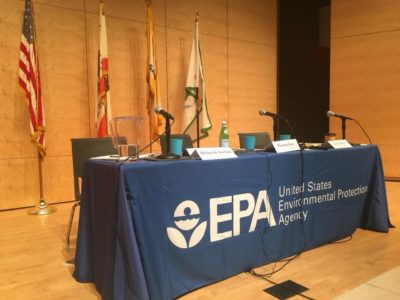U.S. Supreme Court Revisits, Tightens Regulatory Takings Limits on Land Use Regulation
California Homeowner’s Takings Challenge to County’s Traffic Impact Fee Heads Back to State Court

On April 12th, the U.S. Supreme Court revisited a constitutional doctrine near and dear to its institutional heart: when and under what circumstances does a land use permit condition violate the Fifth Amendment’s Takings Clause?
In yet another “regulatory takings” case from California, the Supreme Court wound up not answering that precise question. Instead, the justices unanimously ruled that the California state courts had applied the wrong constitutional standard to the case, and remanded it back to the lower courts for a fresh look at the property rights dispute. The Supreme Court decision is Sheetz v. County of El Dorado.
I explained the factual background and relevant regulatory takings principles in a previous Legal Planet post published when the Supreme Court granted review last fall. Briefly, the Sheetz case arose out of El Dorado County’s 2004 adoption of a new General Plan to govern the county’s land use planning and to manage the county’s future growth. A key provision of the General Plan requires that those proposing new development projects in the county–- housing subdivisions, commercial projects, etc.–-reimburse the county for its costs for the publicly-funded road improvements needed to serve those private projects and mitigate the adverse traffic impacts that they create. The county implemented this policy by creating a “traffic impact mitigation” (TIM) fee program.
County resident George Sheetz sought and obtained county approval of a permit to construct a single-family home on his rural property. However, the county conditioned that approval upon Sheetz’s payment of a $23,420 TIM fee for adjacent highway and road improvements. Sheetz paid the fee under protest, claiming its imposition was unconstitutional. He subsequently sued the county in California state court to pursue his constitutional challenge.
Which brings us to a quick review of applicable regulatory takings law.
The U.S. Supreme Court first declared a century ago that government regulation of private property, if “excessive,” can constitute a compensable “regulatory taking” of private property under the Takings Clause of the Fifth Amendment to the U.S. Constitution. But it was not until the late 1970’s and 1980’s that the Supreme Court first began articulating the details of regulatory takings law.
In 1987, the Court decided the seminal regulatory takings case Nollan v. California Coastal Commission. In Nollan, the Coastal Commission had conditioned its approval of a beachfront home construction project on the landowner’s grant of an access easement allowing members of the public to cross a strip of the Nollans’ dry sand property in order to access public parks on either side of the Nollan parcel. The Supreme Court struck down the easement as an unconstitutional condition in violation of the Takings Clause because, in the majority’s view, the access condition lacked an “essential nexus” connecting it to a legitimate governmental interest.
Seven years later, in Dolan v City of Tigard, the Court returned to its newly-minted “unconstitutional conditions” doctrine. In Dolan, a property owner challenged a city’s conditioning of its commercial land use permit on the property owner’s dedication of a portion of his lot to the city for a publicly-funded storm drainage system and a public pedestrian/bicycle pathway. Again, the justices invalidated the dedication condition as violative of the unconstitutional conditions doctrine they had first announced in Nollan. But in Dolan the Court expanded that doctrine by adding a second component to the constitutional standard: that the imposed condition must be “roughly proportional” to the estimated impact of the proposed development on the public at large.
Finally, in the 2013 case of Koontz v. St. Johns River Water Management District, the Supreme Court held that its two-part “unconstitutional conditions” takings test was not limited to government exactions of interests in private land, but also extends to monetary exactions intended to further a comparable public purpose.
Significantly, the land and fee exactions challenged successfully in the Nollan, Dolan and Koontz decisions all involved exactions imposed by land use regulators on an individualized basis–-not as part of a general, broadly-applicable legislative mandate like the TIM fee program adopted and implemented by the El Dorado County Board of Supervisors.
That distinction has in the past been deemed important by California’s state courts and those of numerous other states: those tribunals have long held that the Nollan/Dolan/Koontz principles don’t apply to broadly-applicable conditions imposed by legislative entities, and rejected Sheetz’s takings claim on that basis. However, other states’ courts have taken the opposite view, concluding that the “unconstitutional conditions” rules apply equally to individualized conditions imposed by administrators and broadly-applicable conditions adopted by government legislative bodies. The Supreme Court took up the Sheetz case to resolve that disagreement among state court systems.
In a unanimous decision, the justices ruled in favor of landowner Sheetz and against El Dorado County, reversing the California lower court rulings. Justice Amy Coney Barrett, speaking for the Court, rejected the distinction relied upon by the county and California courts to reject Sheetz’s regulatory takings claim: “Nothing in constitutional text, history, or precedent supports exempting legislatures from ordinary takings takings rules,” wrote Justice Barrett. She continued:
“[T]here is no basis for affording property rights less protection in the hands of legislators than administrators. The Takings Clause applies equally to both–which means that it prohibits legislatures and agencies alike from imposing unconstitutional conditions on land-use permits.”
This ruling was unsurprising, given what happened during the oral arguments heard by the justices in the case last January: legal counsel for the County conceded for the first time during those arguments that the same regulatory standard must be applied to individually- and legislatively-imposed land use conditions.
Game over? Not quite.
Justice Barrett’s opinion does not address the next logical issue raised by the Sheetz litigation: whether the TIM fee assessed against Mr. Sheetz passes muster under the Nollan/Dolan/Koontz constitutional standard. Instead, in remanding the case back to the California state courts, Justice Barrett wrote that “[w]e do not address whether a permit condition assessed on a class of properties must be tailored with the same degree of specificity as a permit condition that targets a particular development.” (Three brief concurring opinions by Justices Sotomayor, Gorsuch and Kavanaugh all take quite different views on this latter issue.)
In this observer’s opinion, El Dorado County and its attorneys would be wise to settle this case on remand and not try to litigate the key question left unresolved by the Supreme Court in its Sheetz decision. The exaction of a TIM fee in excess of $23,000 for Mr. Sheetz’s modest, prefabricated single-family home seems at first glance to be rather excessive. And–as I and most future lawyers learned in law school–hard facts make bad law.
The Sheetz decision is but the latest example of the Supreme Court’s strong and longstanding interest in the Takings Clause and principles of regulatory takings in particular. As the Court has demonstrated in numerous decisions over the past 40 years, its takings opinions reflect a heightened regard for private property rights as compared to government’s traditional exercise of its police power authority.
Finally, the Sheetz ruling is the first of six different cases the justices have taken up this Term that portend major changes to both environmental and constitutional law principles of major interest to Legal Planet’s readers. Decisions in the other five cases will be handed down before the end of June. This is without question a critically important–and worrisome–Supreme Court Term.
Reader Comments
3 Replies to “U.S. Supreme Court Revisits, Tightens Regulatory Takings Limits on Land Use Regulation”
Comments are closed.







Thank you, Professor Frank.
Can you please enumerate are those 5 additional major environmental-constitutional cases that will be handed down before the end of June?
All six USSC cases are identified and previewed in a 1/3/24 Legal Planet post I published. Here’s the link: ttps://legal-planet.org/2024/01/03/the-u-s-supreme-court-environmental-law-in-2024/. All are straight-up environmental cases, except for SEC v. Jarkesy, a securities regulation case that nonetheless has major potential implications for government enforcement of federal environmental laws.
Thank you, Professor Frank.
I’m curious what are the differences and similarities between “regulatory taking” and “expropriation”.
Could you please introduce them briefly or provide some materials?
I’m a law school student in Taiwan and want to research environmental law. Thank you!